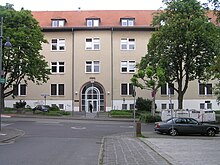Jägerkaserne (Bad Homburg)
The so-called Jägerkaserne is a building in Bad Homburg vor der Höhe with the address Kaiser-Friedrich-Promenade 8-10. It is available as part of the overall plant spa district under monument protection .
history
From 1854 to 1858 the hunter barracks was built under the last Landgrave of Hessen-Homburg , Ferdinand . Hessen-Homburg was obliged to contribute 200 hunters to the federal army . These were initially housed in private households. After the hunter barracks were built, they were used as quarters. The Hessen-Homburg military took part in the Schleswig-Holstein War in 1849 . The Hesse-Homburg contingent marched north on April 28, 1849 and performed field guard duty there . Landgrave Ferdinand donated a field service badge for this .
After Ferdinand's death and the German War , Homburg briefly became part of the Grand Duchy of Hesse in 1866 . Here the two Homburg companies were incorporated into the army of the Grand Duchy as the "Landgravial Hessian Sniper Corps". During the German War , the Homburg troops fought against Prussia under Major von Raunfeld . The sniper Georg Friedrich Kofler, the only Homburg soldier, was killed near Aschaffenburg. In September 1866 the troops returned to Homburg, which had now become Prussian, after the war was lost. 90 soldiers and 9 officers were taken over into the Prussian army and distributed to different units.
From 1867 to 1870 the III. Battalion of the 2nd Kurhessisches Infantry Regiment No. 82 stationed.
The Prussian military used the barracks from July 11, 1871 as the seat of the III. Battalion of the Fusilier Regiment "von Gersdorff" (Kurhessisches) No. 80 . The eighties memorial in Bad Homburg also commemorates the regiment .
In 1914 the regiment entered the First World War . After its end, Bad Homburg was in the demilitarized zone, so no further military use was possible. In the early 1920s, the Holex chocolate factory from Kirdorf moved into the vacant building. Until 1929 chocolate was packed, stored and shipped here. Holex went bankrupt in 1929. From 1934 the Reich Labor Service used the barracks as a labor camp. On the night of March 8, 1945, Bad Homburg was the target of American air raids. The barracks were badly damaged.
From 1946 the building was rebuilt and from 1951 the building was used by the Bad Homburg tax office. Until now the tax office was located in the former Hotel Adler in Louisenstrasse . However, since the original 40 employees had grown to 130, there was not enough space. After the reconstruction, the old barracks had 90 offices. This current old building has been expanded over time with ancillary buildings. The tax office has around 360 employees in 2016.
Starting in January 2016, the building will be renovated for a two-year period. Part of this renovation is the energetic renovation. This should save 90 tons of CO 2 annually.
The street at right angles to the Kaiser-Friedrich-Promenade at the height of the building is called Kasernenstraße .
Building description
In 1907 the barracks consisted of the main building and several auxiliary buildings, namely the garrison hospital building, No. 8, the latrine, the hospital barracks, the morgue, the porter's house, the company's wash house, the wash house of the garrison administration and the living and detention center.
In addition to the living rooms on all floors in the basement, the three-story main building contained the crew kitchen, the officers kitchen, the officers dining room, the canteen with the crew dining room, the guard room, a magazine and basement rooms.
On the ground floor there were four apartments for married sergeants, each consisting of a kitchen and two rooms, the infirmary, four sergeant's offices, four team rooms, the officers' casino and a kitchen. On the first and second floors there were 13 rooms each for officers and men. In the attic there were four assembly chambers, eight rooms for teams and the clock room.
In 1923 the company's wash house and the latrine building were demolished. In 1924 the gatehouse was added at the entrance. In 1927, the garrison hospital building No. 8 and the hospital barrack were converted into a residential building (No. 8, “residential building on the left in the courtyard”) and a residential barrack with five small apartments for workers.
swell
- Gerta Walsh: Homburg becomes a garrison town; in: Taunuszeitung from July 27, 2013, online
- Gerta Walsh: Embroidered Cross for the Fallen; in: Taunuszeitung from August 10, 2013 online
- Alexander Wächtershäuser: Two-year renovation of the building - tax office moves; in: Taunuszeitung from September 2, 2015, online
- Anke Hillebrecht: Bad Homburg tax office - the tax office of the future; in: Taunuszeitung from November 19, 2016, online
- Anke Hillebrecht: barracks, chocolate factory, now authority; in: Taunuszeitung from November 19, 2016, p. 11
- For the history of the Bad Homburg tax office, see: Susanne Meinl, Jutta Zwilling: Legalized robbery: the plundering of Jews under National Socialism by the Reich Finance Administration in Hesse, 2004, ISBN 9783593376127 , p. 319, online
Web links
Individual evidence
- ↑ State Office for the Preservation of Monuments in Hesse (ed.): Complete complex of the spa district In: DenkXweb, online edition of cultural monuments in Hesse
- ↑ Heinz Grosche: History of the city of Bad Homburg in front of the height . Edited by the Magistrate of the City of Bad Homburg vor der Höhe; Part 3. Die Kaiserzeit, 1986, ISBN 3-7829-0334-X , pp. 37–43
- ^ Kaiser-Friedrich-Promenade 8/10, barracks building No. 10, main building. Bad Homburg digital building book. (As of November 2019). In: Landesgeschichtliches Informationssystem Hessen (LAGIS).
Coordinates: 50 ° 13 ′ 48.1 ″ N , 8 ° 36 ′ 56.3 ″ E
